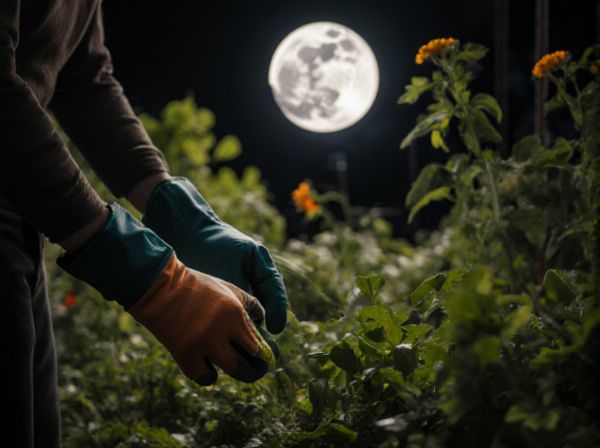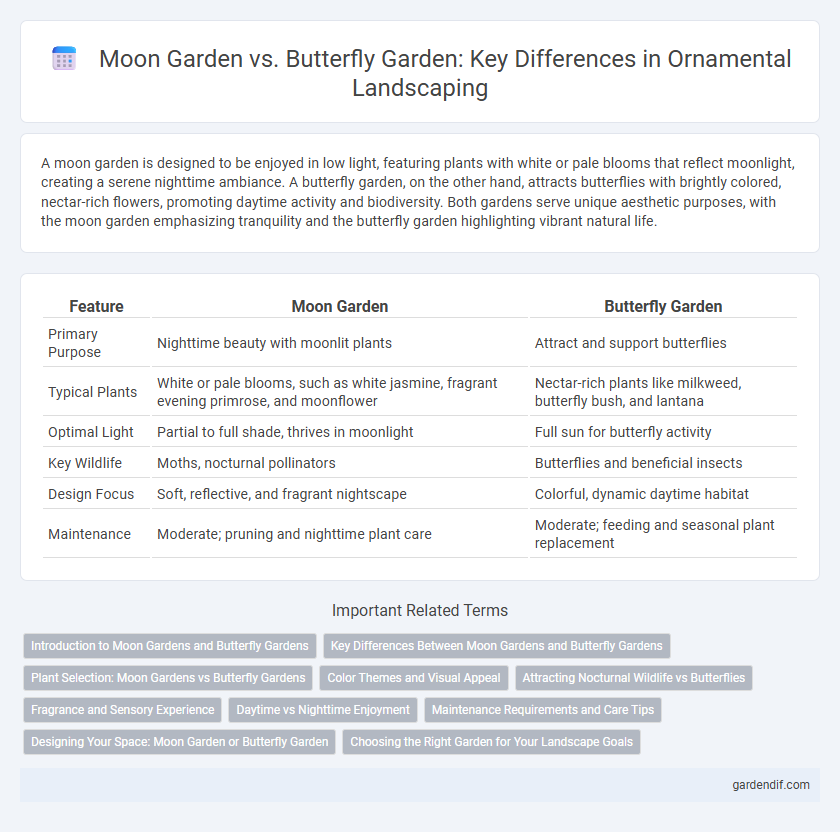
moon garden vs butterfly garden Illustration
A moon garden is designed to be enjoyed in low light, featuring plants with white or pale blooms that reflect moonlight, creating a serene nighttime ambiance. A butterfly garden, on the other hand, attracts butterflies with brightly colored, nectar-rich flowers, promoting daytime activity and biodiversity. Both gardens serve unique aesthetic purposes, with the moon garden emphasizing tranquility and the butterfly garden highlighting vibrant natural life.
Table of Comparison
| Feature | Moon Garden | Butterfly Garden |
|---|---|---|
| Primary Purpose | Nighttime beauty with moonlit plants | Attract and support butterflies |
| Typical Plants | White or pale blooms, such as white jasmine, fragrant evening primrose, and moonflower | Nectar-rich plants like milkweed, butterfly bush, and lantana |
| Optimal Light | Partial to full shade, thrives in moonlight | Full sun for butterfly activity |
| Key Wildlife | Moths, nocturnal pollinators | Butterflies and beneficial insects |
| Design Focus | Soft, reflective, and fragrant nightscape | Colorful, dynamic daytime habitat |
| Maintenance | Moderate; pruning and nighttime plant care | Moderate; feeding and seasonal plant replacement |
Introduction to Moon Gardens and Butterfly Gardens
Moon gardens highlight night-blooming plants like white jasmines and moonflowers, designed to reflect moonlight and create a serene, glowing atmosphere. Butterfly gardens incorporate nectar-rich flowers such as milkweed and purple coneflowers to attract and sustain various butterfly species throughout the day. Both garden types emphasize specific plant selections that enhance sensory experiences and wildlife attraction, tailored to different times and ecological purposes.
Key Differences Between Moon Gardens and Butterfly Gardens
Moon gardens are designed to be visually striking at night, featuring white or pale-colored flowers like moonflowers and white roses that reflect moonlight, creating a luminous ambiance. Butterfly gardens prioritize bright, nectar-rich flowers such as milkweed, coneflowers, and lantanas to attract and support various butterfly species throughout the day. The primary difference lies in the purpose: moon gardens enhance nighttime aesthetics with fragrant and reflective plants, while butterfly gardens focus on biodiversity and pollinator attraction in daylight.
Plant Selection: Moon Gardens vs Butterfly Gardens
Moon gardens emphasize plants with white or pale, reflective flowers like white roses, evening primrose, and moonflowers that glow under moonlight, creating a serene nighttime ambiance. Butterfly gardens prioritize nectar-rich, brightly colored plants such as milkweed, butterfly bush, and coneflowers to attract and support diverse butterfly species. Selecting the right plants depends on the garden's purpose--moon gardens enhance nocturnal visual appeal, while butterfly gardens promote pollinator activity and biodiversity during the day.
Color Themes and Visual Appeal
Moon gardens emphasize white, silver, and pale blue flowers to create a luminous nighttime display, leveraging plants like jasmine, white roses, and lamb's ear for soft, glowing appeal. Butterfly gardens feature bright, vivid colors such as orange, yellow, red, and purple through plants like butterfly bush, coneflowers, and lantana, designed to attract and support butterfly pollinators. The contrasting palettes define their visual appeal: moon gardens offer serene, ethereal beauty under moonlight, while butterfly gardens provide vibrant, lively scenes filled with movement and color diversity.
Attracting Nocturnal Wildlife vs Butterflies
Moon gardens are designed with white or pale, night-blooming flowers that emit strong fragrances to attract nocturnal wildlife such as moths and bats, enhancing evening garden ambiance. Butterfly gardens emphasize vibrant, nectar-rich flowers like milkweed and lantana which specifically draw a variety of daytime butterflies, supporting pollinator health. Choosing between a moon garden and a butterfly garden depends on whether the goal is to foster nocturnal ecosystems or to provide habitat for diurnal pollinators.
Fragrance and Sensory Experience
Moon gardens emphasize nocturnal fragrance, featuring plants like night-blooming jasmine and evening primrose that release captivating scents after dusk, enhancing nighttime sensory experience. Butterfly gardens prioritize flowering nectar sources such as milkweed and butterfly bush, attracting colorful butterflies and creating a vibrant visual and olfactory stimulation during daylight. The distinct sensory focus makes moon gardens ideal for serene evening enjoyment, while butterfly gardens offer lively, multi-sensory appeal in sunlight.
Daytime vs Nighttime Enjoyment
A moon garden is designed to maximize nighttime enjoyment with fragrant white or pale flowers that reflect moonlight, such as night-blooming jasmine and moonflowers, creating a luminous and tranquil ambiance after dusk. In contrast, a butterfly garden thrives during the daytime, featuring vibrant, nectar-rich blooms like milkweed and coneflowers that attract butterflies and pollinators under sunlight. Selecting between the two depends on when outdoor viewing is preferred: moon gardens offer serene nocturnal beauty, while butterfly gardens provide lively daytime activity.
Maintenance Requirements and Care Tips
Moon gardens require low-maintenance plants that thrive in partial to full shade, such as white-flowering perennials and silver-leafed foliage, ensuring minimal watering and pruning. Butterfly gardens demand more frequent care, including regular watering, deadheading, and the planting of host plants like milkweed and nectar-rich flowers to attract and support various butterfly species. Both garden types benefit from organic mulch to retain soil moisture and suppress weeds, but butterfly gardens typically need more attentive seasonal upkeep to sustain pollinator habitats.
Designing Your Space: Moon Garden or Butterfly Garden
Designing your outdoor space as a moon garden emphasizes planting fragrant, night-blooming flowers like white jasmine and moonflowers to create a serene, silver-lit atmosphere perfect for evening relaxation. In contrast, a butterfly garden focuses on incorporating nectar-rich plants such as milkweed, coneflowers, and butterfly bushes that attract and support local butterfly populations during daylight hours. Choosing between these garden styles depends on whether you prioritize tranquil nighttime aesthetics or vibrant daytime wildlife activity.
Choosing the Right Garden for Your Landscape Goals
Selecting the right garden type depends on your landscape goals and ecological preferences. A moon garden emphasizes fragrant, pale-colored plants that glow under moonlight, creating a serene nighttime retreat ideal for relaxation and evening enjoyment. In contrast, a butterfly garden prioritizes native nectar-rich flowers and host plants that attract and support pollinators, enhancing biodiversity and ecological balance in your yard.
moon garden vs butterfly garden Infographic

 gardendif.com
gardendif.com